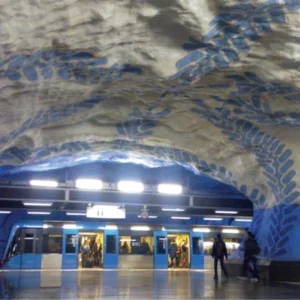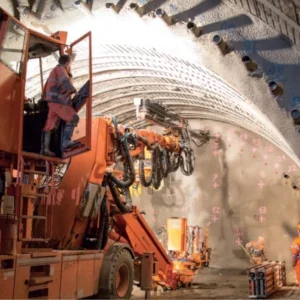In 1985 Swiss company Weidmann started manufacturing a range of glass fibre reinforced plastic (GRP) rockbolts, which were then used for the first time in tunnelling projects in Switzerland. The GRP bolts were installed as permanent support together with steel mesh and shotcrete in numerous tunnels constructed in the single shell method.
GRP bolt technology has since found widespread application in mining and civil engineering. Compared to steel, GRP has advantages that can be traced to the properties of the composite material. It offers high resistance to corrosion, high tensile strength, is lightweight and is easily cut through.
The application of glass fibre reinforced plastics offers various possibilities. In cooperation with Rockbolt Systems of Switzerland, the Minova group offers a range of GRP bolts suitable for various rock support applications.
Minova RSA has also developed a range of thin sprayed linings (TSL) suitable for use as underground containment support or for weathering protection.
GRP basics
GRP bolts simply consist of a composite of resin and fibre that is manufactured through the pultrusion manufacturing process which was developed in the early ’70s. The raw materials (fiber and resin) are pulled through a die, which gives the rods shape and dimension. The rods consist of approximately 75 per cent glass fiber and 25 per cent resin. The fiber threads are continuous without damage or cutting of fibres during the manufacturing process.
Due to the high tensile strength and relatively high modules of GRP, the bolt has a high and immediate load bearing capacity if applied with fast setting resin capsules. The high flexibility is well suited for application without couplings in confined locations and the low weight facilitates ease of handling. The high resistance to corrosion of GRP bolts makes them ideal for use in highly corrosive environments.
GRP bolts have several advantages if compared to steel bolts:
Corrosion resistant – durable material and as part of the final lining supports a structure during its whole life span
Cutability – avoids damage to cutter heads and does not delay excavation Continuous thread – threaded over the whole length facilitates coupling High tensile strength – approximately double the load of a steel bar with the same diameter
Flexibility – GRP bolts can bend and therefore be used in confined spaces without the use of coupling elements
Low weight – A GRP bolt weight is only a quarter of the weight of a steel bolt of the same dimension.
Types of GRP bolts
GRP bolts are well suited as primary or secondary support as a standalone support unit or as an integral part of support systems. There are four different types of GRP bolts available namely, the all thread bolt K60 and J64, the self drilling tubular rod and the cable bolt.
K60 and J64 bolt
The all thread K60 bolt can easily be installed using polyester resin capsules, which lends it very well towards mechanisation, or it can be grouted into place by the use of cement capsules or pumpable grout.
The J64 injection bolt (tube) was developed to facilitate the injection of cementitious grout, epoxy or silicate resin for ground consolidation or water sealing applications.
Self-drilling bolt
The self-drilling bolt was developed for use in weak rock or soil and can be coupled to lengths up to 20m, depending on rock or soil conditions. The bolts are suitable for use with a rotary drilling machine and can effectively penetrate rock with a hardness of approximately 60MPa.
The bolts are set in place with cementitious grout or chemical grout and are most suitable for piling ahead of an advancing face developed in poor ground conditions.
GRP Mesh
FiReP fibre reinforced polymer (FRP) Powermesh was developed to comply with standard grid applications while providing the added benefits of durability and cut ability. High load capacity at each joint, compared to that of welded mesh, is unique and makes the design of FRP grid reinforced concrete structures a viable option for engineers and mining support structures.
Example:
- Unit Standard 100 x 100 x 6mm, rod diameter 6mm
- Breaking load of 6mm rod > 28.3kN.
- Ultimate strength of 6 mm rod >1,000N/mm²
- Tensile E-Modulus 60,000N/mm² and load of knot >3kN and >5kN
- Overall dimensions 2,000 x 800mm Other Options:
- Available rod size 3mm to 12mm
- Other mesh sizes available on request
- Polyester / epoxy / vinyl ester resin
- Non flammable
- Anti-static coating
FiReP FRP rockbolt systems are corrosion resistant and the only currently available rockbolt system which can be regarded as permanent, even under difficult conditions with aggressive water and rock deformations. Corrosion is the most pressing material problem worldwide. With capital, downtime and material costs rising, corrosion prevention is high on many industries’ list of priorities. Every minute, several tons of steel are lost to corrosion. The cost of corrosion protection is enormous. Even with protection the corrosion problem is only delayed but not solved. Correctly applied FiReP FRP rockbolt systems support the construction over its entire life.
Because of its anti-corrosion concept, the FiReP FRP rockbolt technology is used increasingly for soil reinforcement and ground anchoring.
Single-lining support systems
Because of the durability of the materials, in-situ concrete shells can therefore be reduced or even eliminated.
This single lining tunnel construction method is widely used in Europe in military and civil caverns. The final support consists solely of rockbolts and reinforced shotcrete. With the achieved improvements of those materials, single lining tunnels will further increase in importance.
The cost reductions, especially in the large scale Alpine cross tunnels are enormous. The construction costs of a railway tunnel for low speed or a highway tunnel with moderate traffic can be reduced by up to 50 per cent.
Applications of GRP
GRP bolt technology is especially well-suited for use as temporary support units where cutter heads are used for excavation in hard or soft ground conditions. The cut ability of GRP allows for the cutters to cut through the bolt without causing damage to the cutting heads and costly delays and can easily be broken in a rock crusher reducing significantly damage to equipment.
GRP bolts are typically used at collieries during stooping operations, the collar and holing positions for raise boring machines or at the collar and holing position for TBMs and in aggressive corrosive environments.
GRP bolts can be used as a standalone support or in combination with various types of support mediums. In poor or friable ground conditions, GRP can be used in combination with webbing, netting, mesh, shotcrete or TSL.
GRP bolts can also be used as self-drilling bolts in the appropriate applications. Resin injection is generally used to inject consolidation resin through the bolt to consolidate the very weak or friable rock.
The very nature of the ‘block cave’ mining method makes it ideal for exploring the benefits that could be derived from the use of GRP technology. The undercut development is sacrificial and the installed support will be destroyed once the undercut blasting and ore production commences.
The installed support will eventually report to the draw points where it could cause obstruction or worse end up on the conveyor belt systems with the potential of cutting the belts or cause obstructions in the crusher. The inherent properties of GRP can overcome the shortcomings of conventional steel type support and enhance safety and productivity.
In areas where poor or friable ground conditions are encountered, it is often necessary to consider the use of containment support in addition to tendon support. Common practice is to install wire-mesh and lacing or shotcrete or a combination of wire-mesh and shotcrete. Although these types of support are generally very effective in stabilising very weak ground conditions, it is time-consuming and costly, not to mention the logistical problems these may create.
Several TSLs suitable for various mining environments and geotechnical conditions are available and could be well suited as additional support or consolidation medium in the undercut level development in a block cave where this may be required. It offers a cost effective support solution as alternative or supplementary support to shotcrete in areas where the building of a structure is not a requirement.
The main advantages of TSLs if compared to shotcrete are the ease of application, speed of application, early strength, much reduced transportation of material, less labour intensive and cost effective. TSLs can be used as a temporary or permanent support medium depending on the requirements and prevailing geotechnical conditions.
As a temporary support medium it can be incorporated into the daily production cycle to maintain safe mining conditions at the face. This allows permanent support to be installed at a later stage without causing unnecessary production delays.
Typical undercut development support strategy and alternate considerations
The support strategy selected for a block cave undercut level is generally site specific, and to a large extent depends on the undercut level design and local conditions. Drift support and reinforcement typically consists of polyester resin capsule anchored bolts.
Resin bolting offers immediate active and permanent support and the support regime is enhanced by the addition of an appropriate TSL applied directly at the development face after the blast and even further enhanced by the installation of the cutable GRP power mesh or synthetic webbing along with TSLs.
Mesh can be installed mechanically by means of a mesh installer unit mounted to the face jumbo.
GRP bolts can be installed with a dedicated bolter unit making use of a carrousel bolting unit. The use of containment support such as shotcrete or mesh is considered only if conditions warrant its use.
GRP bolts are well suited to be used in the mechanised environment and hence can be used as an alternative to conventional steel bolts without compromising productivity or safety. It can also be used in combination with TSLs, shotcrete and mesh. GRP bolts are approximately 20 per cent more expensive than resin anchored steel bolts of the same diameter. However, in some mining applications the benefits that are being derived from GRP far outweigh the additional cost.
Shotcrete and or wire-mesh are commonly used to support undercut drifts where the containment of rock support may be required to ensure that excavations remain open and safe for their designed life. However, shotcrete or wire-mesh does not readily fit in with the development cycle and often result in reduced development efficiencies or support backlog.
Should the mining conditions permit, TSL may be considered a cost effective alternative or addition to shotcrete and other types of containment support. The main advantage of TSL is that it can easily be integrated into the mining cycle providing support concurrent with the face.
A combination of GRP mesh or synthetic webbing covered by a layer of appropriate TSL along with GRP bolt installations and followed by structural thickness of shotcrete makes much sense in a sacrificial development environment.
Conclusion
With technological advancement of support products and methodologies today, we are able to work safer, smarter and more productive with appropriate support requirements for our excavations. The combination of a fully mechanised system of support commencing with the making safe of a working development end with a scaler and high pressure water jetting of the rock surface to eliminate smaller rock pieces from falling uncontrolled, followed by the mechanised installation of a webbing if required and this being covered with an appropriate thick layer of the correct TSL, allows in-line development activities to take place at higher tempos and perhaps safer than we generally do today.
The application of a then thinner layer of shotcrete on top of the TSL and webbing and bolts due to the already installed support completes a well supported development end with good quality support installed safely.
The author believes that there is much merit in further study of the economical application and implementation of appropriate new technology in underground operations.






